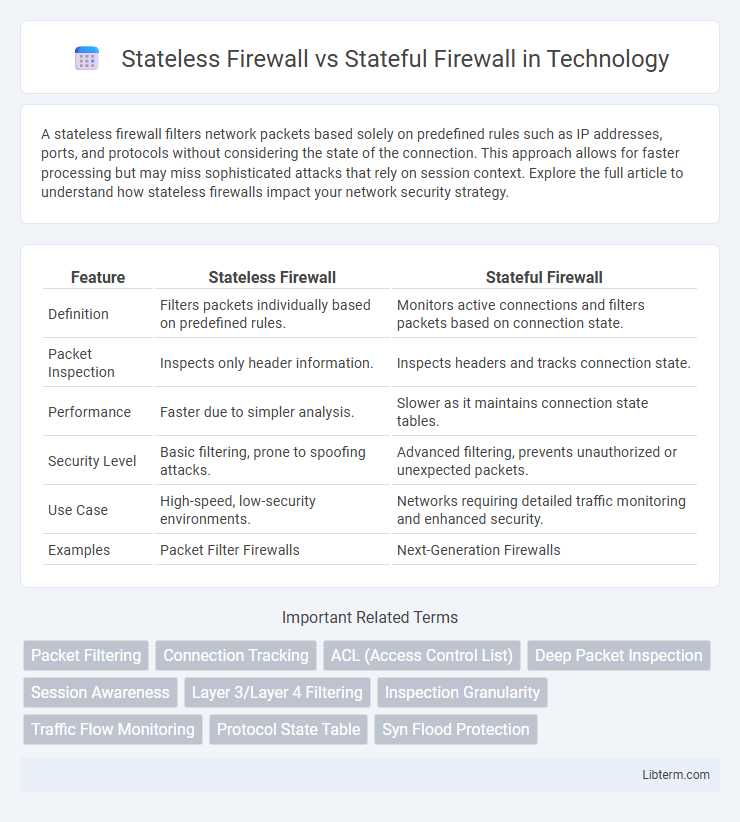A stateless firewall filters network packets based solely on predefined rules such as IP addresses, ports, and protocols without considering the state of the connection. This approach allows for faster processing but may miss sophisticated attacks that rely on session context. Explore the full article to understand how stateless firewalls impact your network security strategy.
Table of Comparison
| Feature | Stateless Firewall | Stateful Firewall |
|---|---|---|
| Definition | Filters packets individually based on predefined rules. | Monitors active connections and filters packets based on connection state. |
| Packet Inspection | Inspects only header information. | Inspects headers and tracks connection state. |
| Performance | Faster due to simpler analysis. | Slower as it maintains connection state tables. |
| Security Level | Basic filtering, prone to spoofing attacks. | Advanced filtering, prevents unauthorized or unexpected packets. |
| Use Case | High-speed, low-security environments. | Networks requiring detailed traffic monitoring and enhanced security. |
| Examples | Packet Filter Firewalls | Next-Generation Firewalls |
Introduction to Firewalls
Stateless firewalls filter packets based solely on predefined rules such as IP addresses, ports, and protocols without considering the state of network connections. Stateful firewalls track the state of active connections and make decisions based on the context of traffic flow, providing enhanced security by monitoring session information. Understanding the distinction between stateless and stateful firewalls is essential for designing effective network security strategies.
What is a Stateless Firewall?
A stateless firewall filters network traffic by examining packets individually based on predefined rules, without considering the context or state of the connection. It operates quickly by analyzing packet headers such as source and destination IP addresses, ports, and protocols, but lacks the capability to track the state of active connections. Stateless firewalls are effective for simple, high-speed filtering tasks but provide less security compared to stateful firewalls, which monitor and analyze the state and context of network sessions.
What is a Stateful Firewall?
A stateful firewall monitors the state of active connections and makes security decisions based on the context of traffic, such as connection status and packet sequence. It tracks the state information of each session, enabling it to distinguish legitimate packets for established connections from unsolicited or potentially harmful traffic. This dynamic inspection provides enhanced security compared to stateless firewalls, which only analyze packets in isolation without considering connection state.
Core Differences Between Stateless and Stateful Firewalls
Stateless firewalls inspect packets individually based on predefined rules without considering the context of a traffic session, making them faster but less secure. Stateful firewalls track the state of active connections and analyze the entire data flow, providing more robust protection against sophisticated attacks by understanding session context. Core differences include packet inspection method, connection awareness, and ability to detect anomalies through stateful packet filtering versus simple rule-based filtering found in stateless systems.
How Stateless Firewalls Work
Stateless firewalls operate by inspecting each packet independently based on predefined rules such as IP addresses, ports, and protocols, without considering the context of the traffic flow. They compare packets to a static set of filters and either permit or block traffic solely on header information, making them faster but less secure against complex attacks. This simplicity limits their ability to track connection states, unlike stateful firewalls that monitor the entire session to make more informed filtering decisions.
How Stateful Firewalls Work
Stateful firewalls monitor the full state of active network connections by analyzing packet headers and tracking session information within a state table. They filter traffic based on context, such as connection state, protocol type, and port numbers, enabling more dynamic and precise security decisions. This method reduces vulnerabilities by allowing only packets matching established connections, unlike stateless firewalls that inspect packets in isolation.
Advantages of Stateless Firewalls
Stateless firewalls provide faster packet processing due to their simpler rule sets, which enhances network performance and reduces latency. These firewalls require less memory and processing power, making them cost-effective solutions for high-speed filtering in large-scale networks. Their ability to quickly filter traffic based purely on predefined rules without tracking session states improves scalability and reliability in environments with heavy traffic loads.
Advantages of Stateful Firewalls
Stateful firewalls track the state and context of active connections, providing enhanced security by monitoring the entire session rather than individual packets. This capability allows them to detect unauthorized access attempts and prevent attacks like IP spoofing more effectively than stateless firewalls. Stateful firewalls also offer better performance in dynamic environments due to their ability to filter traffic based on state, protocol, and port, reducing false positives and improving network reliability.
Use Cases: When to Choose Stateless vs Stateful
Stateless firewalls excel in high-performance environments requiring simple, fast packet filtering without maintaining connection state, making them ideal for basic IP filtering and DNS server protection. Stateful firewalls are suited for complex networks demanding deep packet inspection, tracking active connections, and enforcing granular security policies in applications like VPNs and web servers. Choosing between them depends on network complexity, resource availability, and security requirements, with stateless favored for speed and simplicity, and stateful chosen for comprehensive security and connection awareness.
Conclusion: Selecting the Right Firewall for Your Needs
Choosing between a stateless firewall and a stateful firewall depends on the specific security requirements and network complexity. Stateless firewalls offer faster performance by filtering packets individually without tracking connection states, suitable for simple, high-speed environments. Stateful firewalls provide enhanced security by monitoring and analyzing the state of active connections, making them ideal for complex networks needing robust protection against sophisticated threats.
Stateless Firewall Infographic

 libterm.com
libterm.com